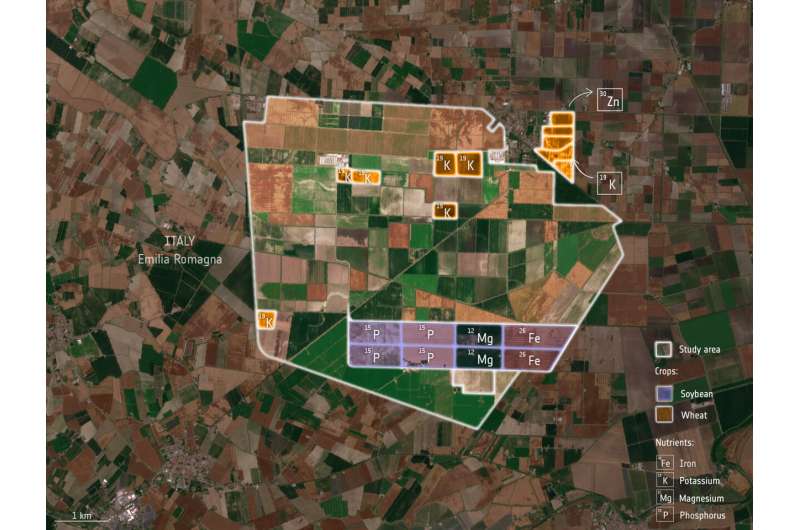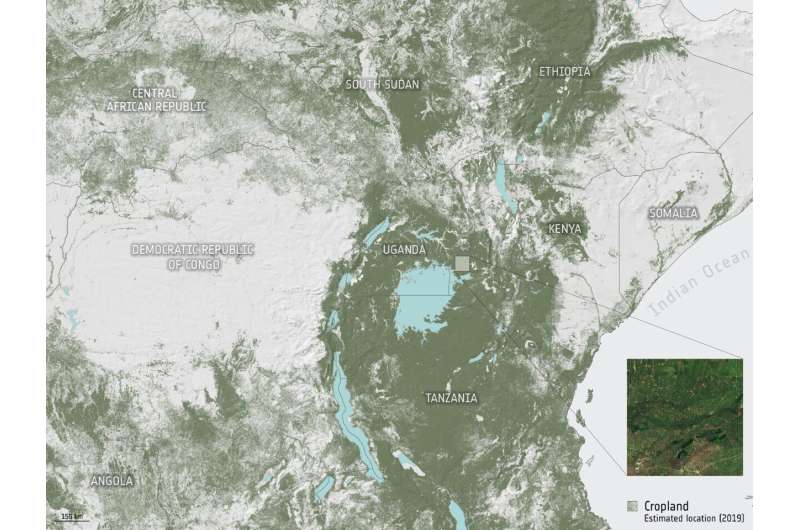This article has been reviewed according to Science X's editorial process and policies. Editors have highlighted the following attributes while ensuring the content's credibility:
fact-checked
trusted source
proofread
Measuring nutrition in crops using satellites

With many people around the world suffering from various forms of malnutrition it's important that the absolute basics such as rice, soya and wheat are as nourishing as possible. Research shows that the Copernicus Sentinel-2 mission and the Italian Prisma mission could be used to monitor the nutritional content of staple crops. This could, for example, help farmers take appropriate steps to boost the quality of their crops as they grow.
Malnutrition from a lack of micronutrients such as calcium and potassium affects more than two billion people—that's over 25% of the global population.
This type of malnutrition is a particular problem for those relying on crop-based diets and limited access to nutrient-rich food.
It is sometimes referred to as a "hidden hunger" because, in some cases, people may be consuming enough calories, but not actually getting enough essential nutrients and vitamins.
This can lead to serious health problems, including impaired physical and mental development, increased susceptibility to various diseases and even premature death.
The rising global population and the climate crisis are already adding to the issue of food security, so ensuring basic crops are as nutritious as possible is becoming increasingly relevant.
Conventional methods for measuring nutrient concentration typically involve collecting grain during the harvesting period and analyzing the samples in a laboratory. These methods are clearly too costly and time-consuming to be applied on a large scale.
In addition, as the nutrients are only measured after harvest, these methods preclude effective intervention with fertilizers while the crop is still growing.
To overcome these limitations, scientists from the University of Twente in the Netherlands and the National Research Council of Italy led research into the potential of using satellites to monitor crop nutrients over large areas and that would give sufficient time for farmers to intervene with fertilizers or other agricultural practices before they actually harvest.

Most satellite optical sensors use a few broad spectral bands that are not sensitive to crop nutritional content.
However, the hyperspectral instrument carried on the Italian Space Agency's Prisma mission and the multispectral instrument carried on the Copernicus Sentinel-2 mission are sensitive to features related to the nutritional content, with their different spectral bands showing varying levels of sensitivity.
The team selected a test site in the Po Valley in Italy and focused on four crops: corn, rice, soybean and wheat. They then compared signals in the satellite data that related to nutrients such as phosphorus, magnesium, zinc and potassium with nutrients measured in the laboratory.
Their research was supported by an ESA Earth Observation Science for Society project called "HyNutri Sensing Hidden Hunger with Sentinel-2 and Hyperspectral."
The team's results have been published in the journal Remote Sensing of the Environment.
Mariana Belgiu, from the University of Twente, said, "These first attempts to estimate and predict micro-and macro-nutrient concentration of staple crops from Prisma and Sentinel-2 are indeed encouraging for some nutrients, such as potassium (K), phosphorous (P), magnesium (Mg) and iron.
"However, for other nutrients the feasibility remains an open question that needs further investigation. Thanks to ESA's Science for Society program, we have launched a follow-on project, EO4Nutri, to take this step."
ESA's Espen Volden noted, "We hope this research will eventually lead to farmers being able to intervene and boost the nutrient quality of grains early in the growing season, or for governments and food security organizations to plan other activities ensuring sufficient nutrients for vulnerable populations.
"This is particularly relevant for countries in Africa, for example, where macro- and micro-nutrient deficiency is more prevalent.
"Looking to the future, a new satellite mission called CHIME, which ESA is developing for Europe's Copernicus program, will carry a new hyperspectral instrument and will also be suitable for determining crop nutrient content—and hopefully help efforts in alleviating hidden hunger."
More information: Mariana Belgiu et al, PRISMA and Sentinel-2 spectral response to the nutrient composition of grains, Remote Sensing of Environment (2023). DOI: 10.1016/j.rse.2023.113567
Provided by European Space Agency





















